Mitsubishi Minica
| Mitsubishi Minica | |
|---|---|

Sixth generation Minica
|
|
| Overview | |
| Manufacturer | Shin Mitsubishi Heavy-Industries (1962–1964) Mitsubishi Motors (1964–present) |
| Also called | Mitsubishi 360, Towny |
| Production | 1962–2011 |
| Assembly | Mizushima plant, Kurashiki, Okayama, Japan |
| Body and chassis | |
| Class | Kei car |
| Related | Mitsubishi Minicab |
| Chronology | |
| Successor | Mitsubishi eK |
| Mitsubishi 360 (commercials) | |
|---|---|
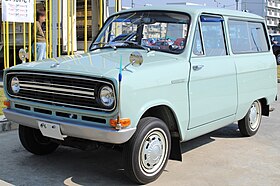
1968-69 Mitsubishi 360 Light Van
|
|
| Overview | |
| Production | 1961–1969 |
| Body and chassis | |
| Body style | 2-door, 2-seater van (LT20) 2-door light van (LT21/23) 2-seat pickup truck (LT22/25) |
| Layout | Front engine, rear-wheel drive |
| Powertrain | |
| Engine |
|
| Dimensions | |
| Wheelbase | 1,900 mm (74.8 in) |
| Length | 2,995 mm (117.9 in) |
| Width | 1,295 mm (51.0 in) |
| Height | 1,390–1,400 mm (54.7–55.1 in) |
| Curb weight | 480–525 kg (1,058–1,157 lb) |
| 1st generation | |
|---|---|
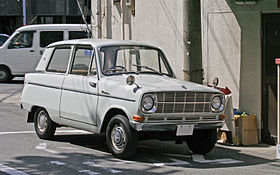
1962 Mitsubishi Minica
|
|
| Overview | |
| Production | 1962.10–1969.07 |
| Body and chassis | |
| Body style | 2-door sedan |
| Platform | LA20/21/23 |
| Powertrain | |
| Engine |
ME21/ME24/ME24D 359 cc air-cooled two-stroke I2 2G10 359 cc two-stroke I2 ME21: 17 PS at 4,800 rpm ME24: 18 PS at 4,800 rpm ME24D: 21 PS at 5,500 rpm 2G10: 23 PS at 5,500 rpm |
| 2nd generation | |
|---|---|
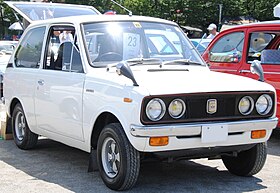
Mitsubishi Minica 70 (A100)
|
|
| Overview | |
| Production | Sedan: 1969–1973 Van: 1969-1981 Skipper: 1971-1974 |
| Body and chassis | |
| Body style | 3-door sedan 2-door wagon 2-door coupé |
| Platform | A100/100V・A101/101V・A102・A104V/105V・A106V |
| Powertrain | |
| Engine |
|
| Dimensions | |
| Wheelbase | 1,900 mm (74.8 in) |
| Length | 2,995 mm (117.9 in) |
| Width | 1,295 mm (51.0 in) |
| Height | 1,305–1,390 mm (51.4–54.7 in) |
| Curb weight | 445–490 kg (981–1,080 lb) |
| 3rd generation | |
|---|---|
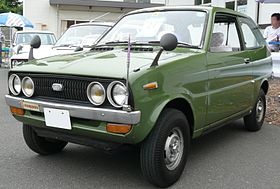
1973/74 Minica F4 GL
|
|
| Overview | |
| Production | 1972–1977 |
| Body and chassis | |
| Body style | 3-door sedan |
| Platform | A103A・A104A |
| Powertrain | |
| Engine | |
| Dimensions | |
| Wheelbase | 2,000 mm (78.7 in) |
| Length | 2,995–3,175 mm (117.9–125.0 in) |
| Width | 1,295–1,395 mm (51.0–54.9 in) |
| Height | 1,315 mm (51.8 in) |
| Curb weight | 515–565 kg (1,135–1,246 lb) |
| Mitsubishi Minica | |
|---|---|
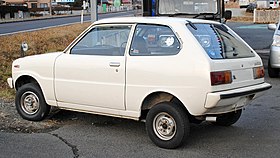
Minica Ami 55 XL (A105A)
|
|
| Overview | |
| Production | 1977 - 1984 |
| Body and chassis | |
| Layout | FR |
| Platform | A105A・A106A・A107A/V |
| Powertrain | |
| Engine | 3 cylinder watercooled |
| Dimensions | |
| Wheelbase | 2,050 mm (80.7 in) |
| Length | 3,175 mm (125.0 in) |
| Width | 1,395 mm (54.9 in) |
| Height | 1,315 mm (51.8 in) |
| Curb weight | 565 kg (1,246 lb) |
| 5th generation | |
|---|---|
 |
|
| Overview | |
| Production | 1984–1989 |
| Body and chassis | |
| Platform | H11A/V・H12V・H14A/V・H15A/V |
| Powertrain | |
| Engine | 546 cc G23B SOHC I2 548 cc 3G81 SOHC I3 783 cc 2G25 SOHC I2 796 cc 3G82 SOHC I3 |
| Dimensions | |
| Wheelbase | 2,260 mm (89.0 in) |
| Length | 3,195 mm (125.8 in) |
| Width | 1,395 mm (54.9 in) |
| Height | 1,430 mm (56.3 in) |
| Curb weight | 580 kg (1,280 lb) |
| 6th generation | |
|---|---|
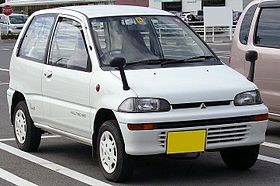
1989 Minica Piace 4WD
|
|
| Overview | |
| Also called | Mitsubishi Towny |
| Production | 1989–1993 |
| Powertrain | |
| Engine | 548 cc 3G81 I3 657 cc 3G83 I3 657 cc 3G83T turbo I3 796 cc 3G82 SOHC I3 |
| Dimensions | |
| Wheelbase | 2,260 mm (89.0 in) |
| Length | 3,195 mm (125.8 in) |
| Width | 1,395 mm (54.9 in) |
| Height | 1,420–1,515 mm (55.9–59.6 in) |
| Curb weight | 580–720 kg (1,280–1,590 lb) |
| Mitsubishi Minica | |
|---|---|
 |
|
| Overview | |
| Production | 1993 - 1998 |
| Layout | FF/optional 4WD |
| Powertrain | |
| Engine | 3G83 series 3 cylinder SOHC 4A30 series 4 cylinder SOHC16 valve 4A30 series 4 cylinder DOHC20 valve intercooled turbo |
| Transmission | 4MT/5MT/3AT/4AT |
| Dimensions | |
| Wheelbase | 2,280 mm (89.8 in) |
| Length | 3,295 mm (129.7 in) |
| Width | 1,395 mm (54.9 in) |
| Height | 1,475–1,505 mm (58.1–59.3 in) |
| Curb weight | 590–780 kg (1,300–1,720 lb) |
| Mitsubishi Minica | |
|---|---|
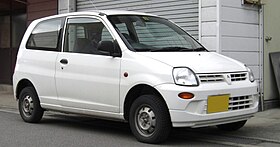 |
|
| Overview | |
| Production | 1998 - 2007 (coupe) 1998 - 2011(sedan) |
| Layout | FF/optional 4WD |
| Powertrain | |
| Engine | 3G83 series 3 cylinder SOHC |
| Transmission | 4MT/5MT/3AT/4AT |
| Dimensions | |
| Wheelbase | 2,340 mm (92.1 in) |
| Length | 3,395 mm (133.7 in) |
| Width | 1,395 mm (54.9 in) |
| Height | 1,475–1,510 mm (58.1–59.4 in) |
| Curb weight | 680–790 kg (1,500–1,740 lb) |
The Mitsubishi Minica is a kei car produced by Mitsubishi Motors for the Japanese domestic market since October 1962. It was first built by Shin Mitsubishi Heavy-Industries, one of Mitsubishi Heavy Industries' three regional automotive companies until they were merged in 1964. It is the oldest Mitsubishi passenger car still in production, and the only one which predates the company itself. In Japan, it was sold at a specific retail chain called Galant Shop. In 2011, the car was replaced with the Mitsubishi eK.
The precursor of the Minica was the Mitsubishi 360, a series of light trucks introduced in April 1961. Designed for the lowest kei car vehicle tax classification, it was powered by an air-cooled 359 cc, 17 PS (13 kW) engine, providing a lowly 80 kilometres per hour (50 mph) top speed but with a fully syncromeshed four-speed transmission. After the successful 1962 introduction of the passenger car version, called Minica, the 360 van and pickup continued alongside the Minica, sharing its development. The Mitsubishi 360/Minica competed with the established Subaru 360, Daihatsu Fellow Max, and the Suzuki Fronte in the late sixties. The somewhat unexpected success of the 360/Minica led Mitsubishi to end production of three-wheeled vehicles.
Originally available as a panel van or light van (really a Station Wagon, but registered as a commercial vehicle for tax purposes), with a pickup version added in October, the Mitsubishi 360 was rather quaintly styled. Suicide doors and a swage line which continued across the hood were often accented by whitewall tires and lace curtains (both standard on the Light Van DeLuxe, introduced in April 1962) to complete the picture. The 360 and Minica were given a thorough facelift in November 1964, with an entirely new front clip with a pressed metal chrome grill. The more modern look was accompanied by the new, somewhat more powerful ME24 engine, affording a top speed of 85 kilometres per hour (53 mph).
The four-seat version of the light van (LT21-4) could carry 200 kg (441 lb), while the strict two-seater (LT20) could take a full 200 kg (441 lb).
...
Wikipedia
